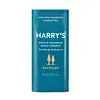What's inside
What's inside
 Key Ingredients
Key Ingredients

 Benefits
Benefits

 Concerns
Concerns

 Ingredients Side-by-side
Ingredients Side-by-side

Aluminum Zirconium Trichlorohydrex Gly 20%
AstringentC12-15 Alkyl Benzoate
AntimicrobialStearyl Alcohol
EmollientIsoamyl Laurate
EmollientDimethicone
EmollientWater
Skin ConditioningHydrogenated Castor Oil
EmollientCetyl Alcohol
EmollientSilica
AbrasiveParfum
MaskingAluminum Starch Octenylsuccinate
AbsorbentSimmondsia Chinensis Seed Oil
EmollientAllantoin
Skin ConditioningBisabolol
MaskingZingiber Officinale Root Extract
MaskingTocopheryl Acetate
AntioxidantMyristyl Alcohol
EmollientCitronellyl Methylcrotonate
MaskingLimonene
PerfumingLinalool
PerfumingAlpha-Isomethyl Ionone
PerfumingBenzyl Alcohol
PerfumingCitral
PerfumingEugenol
PerfumingPentaerythrityl Tetra-Di-T-Butyl Hydroxyhydrocinnamate
AntioxidantAluminum Zirconium Trichlorohydrex Gly 20%, C12-15 Alkyl Benzoate, Stearyl Alcohol, Isoamyl Laurate, Dimethicone, Water, Hydrogenated Castor Oil, Cetyl Alcohol, Silica, Parfum, Aluminum Starch Octenylsuccinate, Simmondsia Chinensis Seed Oil, Allantoin, Bisabolol, Zingiber Officinale Root Extract, Tocopheryl Acetate, Myristyl Alcohol, Citronellyl Methylcrotonate, Limonene, Linalool, Alpha-Isomethyl Ionone, Benzyl Alcohol, Citral, Eugenol, Pentaerythrityl Tetra-Di-T-Butyl Hydroxyhydrocinnamate
Caprylic/Capric Triglyceride
MaskingMaranta Arundinacea Root Powder
Skin ConditioningStearyl Alcohol
EmollientMagnesium Hydroxide
AbsorbentBeeswax
Emulsion StabilisingButyrospermum Parkii Butter
Skin ConditioningCocos Nucifera Oil
MaskingTriethyl Citrate
MaskingSimmondsia Chinensis Seed Oil
EmollientParfum
MaskingJojoba Esters
EmollientCharcoal Powder
AbrasiveHelianthus Annuus Seed Oil
EmollientTocopherol
AntioxidantLactobacillus Ferment
Skin ConditioningMaltodextrin
AbsorbentCaprylic/Capric Triglyceride, Maranta Arundinacea Root Powder, Stearyl Alcohol, Magnesium Hydroxide, Beeswax, Butyrospermum Parkii Butter, Cocos Nucifera Oil, Triethyl Citrate, Simmondsia Chinensis Seed Oil, Parfum, Jojoba Esters, Charcoal Powder, Helianthus Annuus Seed Oil, Tocopherol, Lactobacillus Ferment, Maltodextrin
Ingredients Explained
These ingredients are found in both products.
Ingredients higher up in an ingredient list are typically present in a larger amount.
Parfum is a catch-all term for an ingredient or more that is used to give a scent to products.
Also called "fragrance", this ingredient can be a blend of hundreds of chemicals or plant oils. This means every product with "fragrance" or "parfum" in the ingredients list is a different mixture.
For instance, Habanolide is a proprietary trade name for a specific aroma chemical. When used as a fragrance ingredient in cosmetics, most aroma chemicals fall under the broad labeling category of “FRAGRANCE” or “PARFUM” according to EU and US regulations.
The term 'parfum' or 'fragrance' is not regulated in many countries. In many cases, it is up to the brand to define this term.
For instance, many brands choose to label themselves as "fragrance-free" because they are not using synthetic fragrances. However, their products may still contain ingredients such as essential oils that are considered a fragrance by INCI standards.
One example is Calendula flower extract. Calendula is an essential oil that still imparts a scent or 'fragrance'.
Depending on the blend, the ingredients in the mixture can cause allergies and sensitivities on the skin. Some ingredients that are known EU allergens include linalool and citronellol.
Parfum can also be used to mask or cover an unpleasant scent.
The bottom line is: not all fragrances/parfum/ingredients are created equally. If you are worried about fragrances, we recommend taking a closer look at an ingredient. And of course, we always recommend speaking with a professional.
Learn more about ParfumThis oil comes from the seeds of the desert shrub called Jojoba. It is more commonly known as jojoba oil, a non-comedogenic oil.
Jojoba oil does not contain fragrance and has many fatty-acids, making it a great soothing ingredient.
It also contains Vitamin E, a great moisturizing ingredient. Vitamin E is also an antioxidant and protects your skin against oxidative damage.
This ingredient humectant properties, meaning it helps draw moisture from the air. This helps keep your skin hydrated.
While jojoba has antibacterial properties, it is only able to kill some strains of bacteria.
Studies also show it helps in wound healing. In fact, Indigenous cultures have used jojoba as a moisturizer and to help treat burns for centuries.
Fun fact: Jojoba oil similar to natural human skin sebum, so it has a great effect on dry skin. It is also promising with helping to regulate sebum production.
Due to its fatty acid content, Jojoba oil may not be fungal acne safe. We recommend speaking with a professional if you have any concerns.
Learn more about Simmondsia Chinensis Seed OilStearyl Alcohol is a type of fatty alcohol from stearic acid. It is a white, waxy compound used to emulsify ingredients.
Fatty Alcohols are most often used as an emollient or to thicken a product. Emollients help soothe and hydrate the skin by trapping moisture.
They are usually derived from natural fats and oils and therefore do not have the same drying or irritating effect as solvent alcohols. FDA allows products labeled "alcohol-free" to have fatty alcohols.
Learn more about Stearyl Alcohol